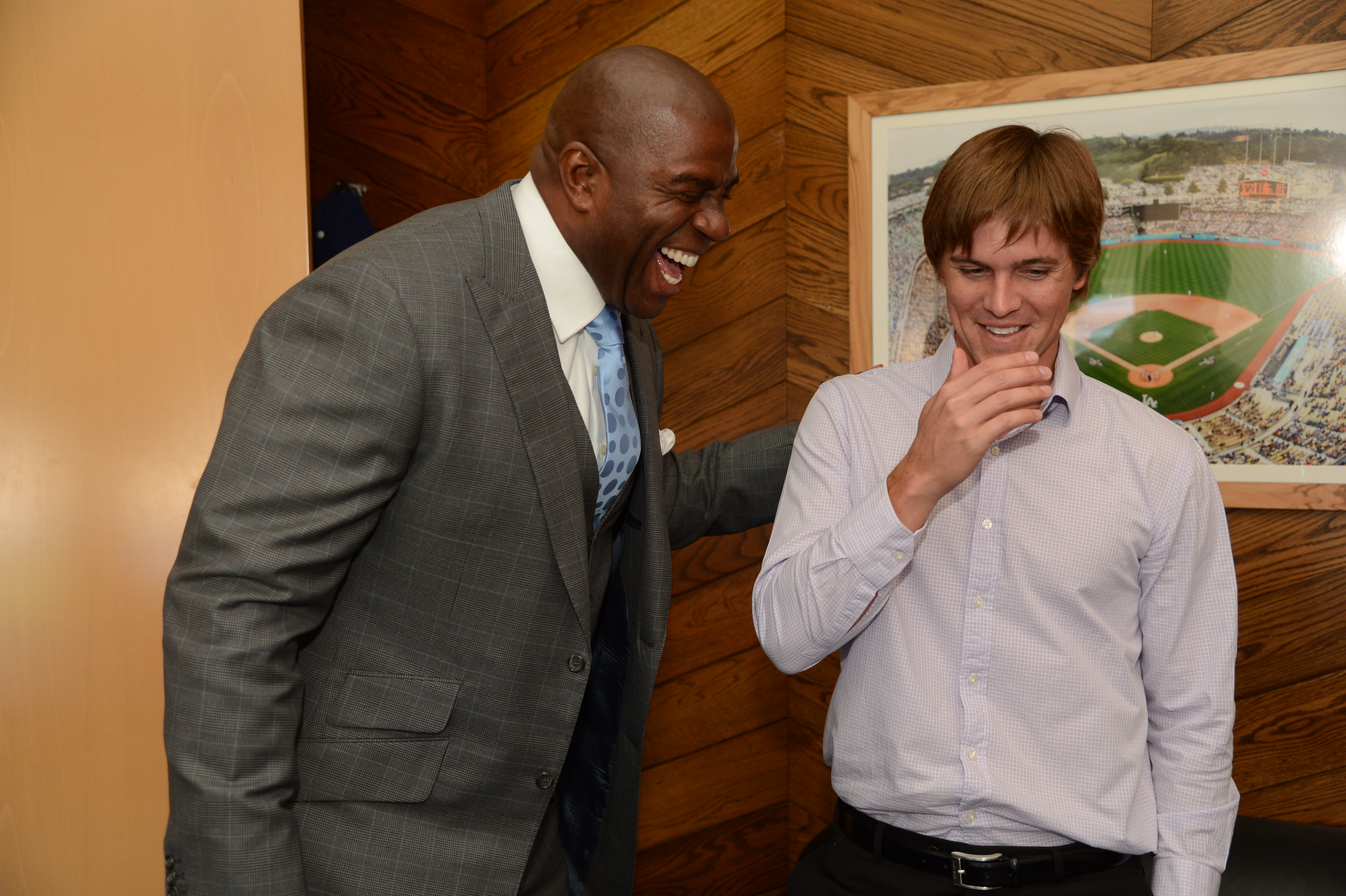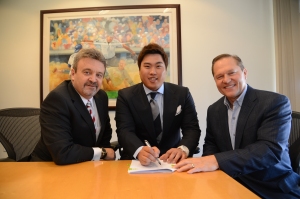
Magic Johnson welcomes Zack Greinke to the Dodgers in December 2012. (Jon SooHoo/Los Angeles Dodgers)
By Jon Weisman
Numerous Dodger fans are on the edge of their seats waiting for the team’s next big move. That might or might not come in December, a month that has brought huge transactions in some years but relative tranquility in others. Here’s a look at the biggest Dodger transactions of December that have taken place in the 21st century:
December 11, 2000: Signed Darren Dreifort to a five-year contract.
The No. 2 overall pick in the 1993 draft behind Alex Rodriguez (whom the Dodgers would have selected if the current draft system had been in place), Dreifort had a World Book of potential but an Encyclopedia Britannica of injuries. The guess here is that Dreifort (coming off a 12-9, 4.16 ERA, 5.06 fielding-independent ERA season in 2000) wouldn’t have gotten this deal in the current analytical climate. He pitched 205 2/3 more innings with an 87 ERA+ before retiring.
December 13, 2001: Acquired Paul Quantrill and Cesar Izturis from the Toronto Blue Jays for Luke Prokopec and Chad Ricketts.
Selling high on the Australian lefty Prokopec, who pitched 138 1/3 innings in 2001, the Dodgers picked up a key bullpen component (2.22 ERA, 1.18 WHIP in 154 innings from 2002-03) in Quantrill and a Gold Glove shortstop in Izturis, who played in 590 games for the Dodgers before turning into Greg Maddux in a July 2006 deadline deal.
December 20, 2001: Signed Hideo Nomo to a two-year contract.
The first era of Nomonia ended ignominiously in June 1998 when the righty was traded (with a 5.05 ERA) with Brad Clontz to the Mets for Dave Mlicki and Greg McMichael. Nomo pitched for four teams in 3 1/2 seasons before returning to the Dodgers, reborn. Over the next two seasons, he had a 3.24 ERA and 7.6 K/9 in 438 2/3 innings.
December 12, 2002: Acquired Todd Hundley and Chad Hermansen from the Chicago Cubs for Eric Karros and Mark Grudzielanek.
In a move more significant for who left than who arrived, Los Angeles bid farewell its all-time leader in home runs and a middle infielder who hit .284 in 605 games with the team. Karros was coming off a season in which he had 13 homers and a .722 OPS in 142 games. The hope was that Hundley, in his second tour with the Dodgers, could bring some power, but the catcher was at the end of his physical rope and managed only two homers in 41 plate appearances before his season and MLB career ended. Karros hit 12 homers with Chicago in 2003 and two with Oakland in 2004 before retiring, but Grudzielanek hit .302 with a .344 on-base percentage over the next six seasons.

Fred McGriff had nine homers in 2003 through May, then hit four in 34 games over the remainder of the season.
December 20, 2002: Signed Fred McGriff to a one-year contract.
Los Angeles planned to replace Karros at first base with McGriff, who had hit 30 homers with the Cubs the year before and was 22 away from 500. The Dodgers even created a countdown sign for the milestone. But at age 39, McGriff was inconsistent, then injured, finishing the year with 13 homers and a .750 OPS in 329 plate appearances. With two homers in his final season, McGriff ended his fine career with 493 circuit clouts.
December 13, 2003: Acquired Jeff Weaver, Yhency Brazoban, Brandon Weeden and cash considerations from the New York Yankees in exchange for Kevin Brown.
Despite his age and injuries, the Brown mega-contract was a good one for the Dodgers. Not only did he produce nearly 900 innings with a 2.83 ERA (147 ERA+), he was then exchanged for two key components of the Dodgers’ first division title of the century in 2004, Weaver (102 ERA+ in 220 innings) and Mr. Ghame Over himself, Brazoban (2.48 ERA, 1.22 WHIP in 32 2/3 innings).
December 9, 2004: Signed Jeff Kent to a three-year contract.
Kent, who ended up staying with the Dodgers through 2008, was a massive offensive success despite starting his Dodger career at age 37, with OPSes of .889, .861 and .875 in his first three seasons. Only Jackie Robinson has a higher adjusted OPS among second basemen with the Dodgers.
December 23, 2004: Signed J.D. Drew to a five-year contract.
Lots of people complained when Drew signed, and then lots of people complained when he opted out after two years. In between, Drew merely put up a .905 OPS, and despite even more whining about his health, his only significant injury came when he was hit by a pitch in a midseason 2005 game.
December 7, 2005: Signed Rafael Furcal to a three-year contract.
Furcal would ended up playing with the Dodgers through the middle of the 2011 season, and when he wasn’t on the disabled list, he was good bordering on brilliant. But he was on the disabled list quite a bit, averaging 116 games from 2006-10. His top season might have been his first, when he played 159 games with an .814 OPS.
December 13, 2005: Acquired Andre Ethier from the Oakland A’s in exchange for Milton Bradley and Antonio Perez.
Bradley did well at the plate as a Dodger, but even longtime defenders (such as myself) were ready to concede that his time to go had arrived by the end of a 2005 season that featured injuries and allegations of domestic abuse. Ethier, an A’s minor-leaguer, wasn’t close to a headline acquisition, but years from now, this will still be considered one of the Dodgers’ top trades of the century. The outfielder had a .365 OBP in 441 plate appearances in 2006, and was a mainstay in the Dodger outfield until (for now) the final two months of the 2014 season. (And no, Perez didn’t parlay that .360 OBP from 2005 into a career).

Nomar Garciaparra rounds the bases after his game-winning blast in the Dodgers’ 11-10 victory on September 18, 2006. (Jon SooHoo/Los Angeles Dodgers)
December 19, 2005: Signed Nomar Garciaparra to a one-year contract.
The former All-Star shortstop took over at first base for the Dodgers in 2006 and had his last big season with the bat, OPSing .872 with 20 homers, including, of course, the winning blow in the 4+1 game. Garciaparra played two more years with the Dodgers, OPSing .725 with 15 homers in 176 games.
December 8, 2006: Signed Jason Schmidt to a three-year contract.
This didn’t exactly go as hoped. He won his first start as a Dodger. Then he won two more.
December 12, 2007: Signed Andruw Jones to a two-year contract.
This didn’t exactly go as hoped, either. Jones was 29 and had hit 92 home runs in 2005-06 and even 26 in 2007. The Dodgers bet on a rebound that never came, except for some part-time success in the AL once the Dodgers had cut him loose. As a Dodger, he had a .256 OBP and .249 slugging percentage in 238 plate appearances. Some quick action on Los Angeles’ part allowed the team to make room for Manny Ramirez in July 2008.
December 16, 2007: Signed Hiroki Kuroda to a three-year contract.
This one went beyond as hoped. Following in the footsteps of countryman Takashi Saito, who made his Major League debut in 2006 at age 36, Kuroda arrived at an advanced age (33 when he made his Dodger debut) and pitched the best ball of his career. Ultimately staying four years in Los Angeles, Kuroda had a 3.45 ERA (115 ERA+, 3.61 FIP, 1.17 WHIP) in 699 innings.

Flanked by Ned Colletti and Scott Boras, Hyun-Jin Ryu signs with the Dodgers in December 2012. (Jon SooHoo/Los Angeles Dodgers)
December 9, 2012: Signed Hyun-Jin Ryu to a six-year contract.
With a Matt Guerrier here or a Chris Capuano there, the Dodgers had been relatively quiet in December for about five years, then took a shot at this 25-year-old from Korea. To say the least, it has paid off. Still in his prime, Ryu has a 3.17 ERA in 344 innings so far with Los Angeles.
December 10, 2012: Signed Zack Greinke to a six-year contract.
In the 13th December of the 21st century, the Dodgers made their biggest investment of all. Outside of his AL Cy Young Award-winning season in 2009, Greinke’s first two Dodger seasons have been the best of his career and by any non-Clayton Kershaw standard, ace-worthy. In 380 innings, Greinke has a 2.68 ERA (132 ERA+) and 8.4 strikeouts per nine innings, not to mention numerous fielding and hitting exploits to savor.









oldbrooklynfan
These are what great memories are made of, minus a pennant or world series triumph.